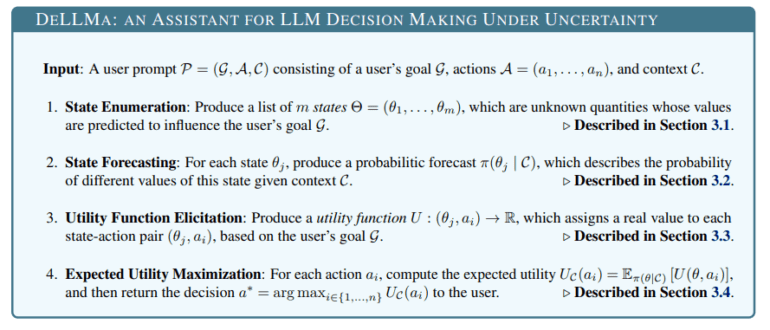- USC researchers unveil DeLLMa, a Decision-making Large Language Model Assistant for uncertain environments.
- DeLLMa bridges gaps in decision-making by leveraging large language models in a transparent, structured procedure.
- The methodology focuses on identifying unknown variables, eliciting utility functions, and maximizing expected utility for rational decision-making.
- Real-world tests in agriculture and finance showcase a remarkable 40% increase in decision accuracy compared to alternatives.
- DeLLMa ensures human auditability, allowing users to trace decision logic for increased trust in high-stakes scenarios.
Main AI News:
Amidst the uncertainties prevalent in decision-making, particularly in critical sectors like business, finance, and agriculture, the demand for tools to navigate this ambiguity is intensifying. Decision-making approaches often require adaptation in the face of intricate, multifaceted issues, revealing a gap that conventional computational methods and human expertise struggle to fill effectively. This gap widens due to human biases, incomplete information, and the limitations of current computational tools, which, while potent, lack the nuanced comprehension necessary to address decisions under uncertainty adeptly.
The University of Southern California researchers introduced DeLLMa, an acronym for Decision-making Large Language Model assistant, to address this challenge. This groundbreaking tool harnesses the extensive capabilities of large language models (LLMs) to aid decision-making in uncertain environments. Drawing from decision and utility theory, DeLLMa presents a unique, multi-step procedure aimed at refining decision accuracy in unpredictable settings. By delineating an optimal and transparent decision-making pathway, DeLLMa surpasses existing methodologies, offering clarity in the ambiguous realm of decision-making under uncertainty.
DeLLMa’s methodology centers on integrating large language models into decision-making processes. Unlike traditional methods reliant on quantitative analysis or human intuition, DeLLMa follows a structured approach. It begins by identifying and predicting relevant unknown variables, followed by eliciting a utility function aligned with user objectives. This ensures decision maximization based on expected utility, promoting rationality and transparency auditable by humans.
DeLLMa’s real-world effectiveness was rigorously assessed in agriculture and finance scenarios, notorious for uncertainty. The framework exhibited remarkable potential, enhancing decision accuracy by up to 40% compared to alternative methods. This significant improvement underscores DeLLMa’s capacity to redefine decision-making in complex scenarios, providing a reliable compass in uncertain domains.
Understanding the rationale behind decisions is critical for confidence in decision-support tools. DeLLMa’s transparent, systematic approach enables users to trace decision logic, fostering trust in the system’s output. Human auditability is vital, particularly in high-stakes situations.
The framework represents a substantial advancement in integrating advanced machine learning models with human decision-making nuances. By offering a structured, transparent approach leveraging LLMs’ data-processing prowess while rooted in decision-theoretical principles, DeLLMa heralds a future where decision-making under uncertainty is not merely endured but navigated with confidence and clarity.
Conclusion:
The introduction of DeLLMa signifies a significant advancement in decision-making technology, particularly in industries marked by uncertainty. Its ability to improve decision accuracy by up to 40% presents a compelling proposition for businesses operating in dynamic environments. Incorporating DeLLMa into decision-making processes can lead to more informed and reliable outcomes, ultimately enhancing competitiveness and mitigating risks in the market.

